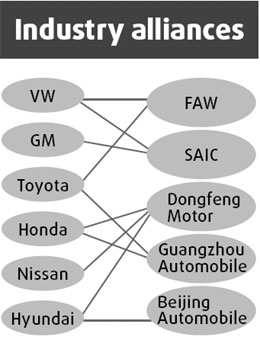Automaker tie-ups a complex network in China
Updated: 2007-12-19 13:38
Partnership with local interests is the only way foreign carmakers can enter the auto-manufacturing industry in China. On paper, the partnership requirement is deemed necessary to protect the local car industry. In application, the Chinese government is effectively prohibiting full equity control.
For foreign carmakers, the primary objective in establishing joint ventures with local interests is to exploit the comparative advantage of local entities in manufacturing parts and components, distribution and after-sales networks.

Along with the increase in the number of partnerships between local carmakers and large foreign auto groups, a complex network of partnerships has emerged in China. The most prevailing pattern in the Chinese manufacturing industry is the "one-to-many" relationship. As with local companies, foreign carmakers can forge ties with a multitude of local providers.
Three issues are causing disputes in the management of partnerships between local interests and foreign companies.
First, partnership with advanced foreign companies can help local firms enhance R&D and management capabilities, while technological advantages for foreign companies become less apparent.
The primary goal of Chinese companies is improvement of R&D and production capabilities. Hence, there is a high probability that partnerships between local and foreign companies will eventually evolve into competition.
Using R&D capabilities cultivated during partnerships with foreign companies (including Rover, Volkswagen and GM), Shanghai Automotive Industry Corp (SAIC) developed its own vehicle, the Roewe 750, which went into showrooms in May. In the few months it has been on the market, a large number of local consumers have opted for the Roewe instead of buying GM's Buick Lacrosse or Volkswagen's Passat.
Second, if local firm C partners with foreign firm B, there is potential for such partnerships to eventually hurt the competitiveness of foreign firm A. When Volkswagen and SAIC churned out Santana models in 1985 under a partnership deal, there was a lack of production lines, with the localization ratio hovering at 2.7 percent. Thereafter, Volkswagen helped SAIC to build auxiliary production facilities, with the localization ratio rising to 40 percent in 1997, when SAIC became a local partner of GM.
|
||
|
|

